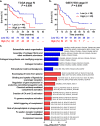Germline variability and tumor expression level of ribosomal protein gene RPL28 are associated with survival of metastatic colorectal cancer patients
- PMID: 31506518
- PMCID: PMC6736932
- DOI: 10.1038/s41598-019-49477-3
Germline variability and tumor expression level of ribosomal protein gene RPL28 are associated with survival of metastatic colorectal cancer patients
Abstract
This study investigated the potential of single nucleotide polymorphisms as predictors of survival in two cohorts comprising 417 metastatic colorectal cancer (mCRC) patients treated with the FOLFIRI (folinic acid, 5-fluorouracil and irinotecan) regimen. The rs4806668G > T of the ribosomal protein gene RPL28 was associated with shorter progression-free survival and overall survival by 5 and 9 months (P = 0.002), with hazard ratios of 3.36 (P < 0.001) and 3.07 (P = 0.002), respectively. The rs4806668T allele was associated with an increased RPL28 expression in transverse normal colon tissues (n = 246, P = 0.007). RPL28 expression was higher in colorectal tumors compared to paired normal tissues by up to 124% (P < 0.001) in three independent datasets. Metastatic cases with highest RPL28 tumor expression had a reduced survival in two datasets (n = 88, P = 0.009 and n = 56, P = 0.009). High RPL28 was further associated with changes in immunoglobulin and extracellular matrix pathways. Repression of RPL28 reduced proliferation by 1.4-fold to 5.6-fold (P < 0.05) in colon cancer HCT116 and HT-29 cells. Our findings suggest that the ribosomal RPL28 protein may influence mCRC outcome.
Conflict of interest statement
The authors declare no competing interests.
Figures





Similar articles
-
Prognostic Effect of Adenosine-related Genetic Variants in Metastatic Colorectal Cancer Treated With Bevacizumab-based Chemotherapy.Clin Colorectal Cancer. 2019 Mar;18(1):e8-e19. doi: 10.1016/j.clcc.2018.09.003. Epub 2018 Sep 13. Clin Colorectal Cancer. 2019. PMID: 30293873 Free PMC article.
-
Randomized phase III study of panitumumab with fluorouracil, leucovorin, and irinotecan (FOLFIRI) compared with FOLFIRI alone as second-line treatment in patients with metastatic colorectal cancer.J Clin Oncol. 2010 Nov 1;28(31):4706-13. doi: 10.1200/JCO.2009.27.6055. Epub 2010 Oct 4. J Clin Oncol. 2010. PMID: 20921462 Clinical Trial.
-
A randomized phase II trial of pemetrexed plus irinotecan (ALIRI) versus leucovorin-modulated 5-FU plus irinotecan (FOLFIRI) in first-line treatment of locally advanced or metastatic colorectal cancer.Oncology. 2007;73(1-2):9-20. doi: 10.1159/000120626. Epub 2008 Mar 11. Oncology. 2007. PMID: 18334829 Clinical Trial.
-
The Clinical and Cost Effectiveness of Aflibercept in Combination with Irinotecan and Fluorouracil-Based Therapy (FOLFIRI) for the Treatment of Metastatic Colorectal Cancer Which has Progressed Following Prior Oxaliplatin-Based Chemotherapy: a Critique of the Evidence.Pharmacoeconomics. 2015 May;33(5):457-66. doi: 10.1007/s40273-015-0257-z. Pharmacoeconomics. 2015. PMID: 25616671 Review.
-
Chemotherapy of metastatic colorectal cancer.Prescrire Int. 2010 Oct;19(109):219-24. Prescrire Int. 2010. PMID: 21180382 Review.
Cited by
-
Cytosolic Ribosomal Protein Haploinsufficiency affects Mitochondrial Morphology and Respiration.bioRxiv [Preprint]. 2024 May 2:2024.04.16.589775. doi: 10.1101/2024.04.16.589775. bioRxiv. 2024. PMID: 38659761 Free PMC article. Preprint.
-
Identifying Novel Susceptibility Genes for Colorectal Cancer Risk From a Transcriptome-Wide Association Study of 125,478 Subjects.Gastroenterology. 2021 Mar;160(4):1164-1178.e6. doi: 10.1053/j.gastro.2020.08.062. Epub 2020 Oct 12. Gastroenterology. 2021. PMID: 33058866 Free PMC article.
-
Deregulation of ribosomal proteins in human cancers.Biosci Rep. 2021 Dec 22;41(12):BSR20211577. doi: 10.1042/BSR20211577. Biosci Rep. 2021. PMID: 34873618 Free PMC article. Review.
-
Differential impacts of ribosomal protein haploinsufficiency on mitochondrial function.J Cell Biol. 2025 Mar 3;224(3):e202404084. doi: 10.1083/jcb.202404084. Epub 2025 Jan 9. J Cell Biol. 2025. PMID: 39786340
-
Mechanism of Tumor-Platelet Communications in Cancer.Circ Res. 2023 May 26;132(11):1447-1461. doi: 10.1161/CIRCRESAHA.122.321861. Epub 2023 May 5. Circ Res. 2023. PMID: 37144446 Free PMC article.
References
-
- Gupta E, et al. Metabolic fate of irinotecan in humans: correlation of glucuronidation with diarrhea. Cancer Res. 1994;54:3723–3725. - PubMed
Publication types
MeSH terms
Substances
Grants and funding
LinkOut - more resources
Full Text Sources
Medical
Molecular Biology Databases

